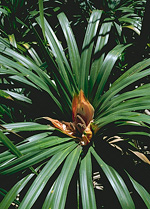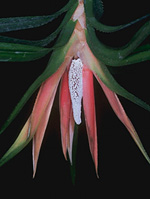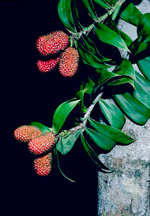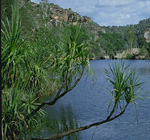 |
This is an Old World, tropical family represented in Australia by two genera. Several species of Freycinetia are found in rainforests of north Queensland, while Pandanus is larger and more widespread, occurring from the Kimberley region of Western Australia, through tropical Northern Territory and Queensland to northern New South Wales, on coastal headlands, in monsoon forests, fringing rivers and streams, and on the edges of rainforests.
Characteristic features of the family Pandanaceae in Australia include: - woody climbers (Freycinetia) or stout, branched or unbranched trees often with prop roots
- leaves spirally arranged (often very distinctly so), more or less linear or sword-shaped with stout marginal prickles
- flowers unisexual, without a perianth, aggregated into dense heads
- fruits large, prominent, comprising an elongate or globular head of
close-packed berries or drupes (Freycinetia and Pandanus)
or a brightly-coloured, pineapple-like, more or less woody compound
fruit (Pandanus).
Description
Evergreen trees, or shrubs, or woody vines climbing by root
suckers. Vegetative reproduction absent, or by stolons. Internal secretions
not obvious. Plants glabrous. Leaves alternate and spiral, petiolate.
Stipule-like lobes absent. Lamina simple, symmetric, filiform, acicular,
subulate, linear, lanceolate, ovate, oblanceolate, obovate or oblong;
base lobed or auriculate; margins entire or spiny, ±flat, revolute
or recurved; venation parallel, with the midrib conspicuous, and the tertiary
venation not reticulate; surfaces not punctate; leathery. Leaf ligule
absent. Male and female flowers occurring on separate plants. Inflorescences
terminal, consisting of spadices, racemes or umbels. Spathes present.
Bracts present. Pollination by insects, birds, bats or wind. Flowers odourless;
sessile. Floral disc absent; nectaries absent. Perianth absent. Fertile
stamens 1–numerous, distinct from each other or fused by their filaments
into an open or closed tube, all ±equal. Staminodes vestigial or
absent. Anthers basifixed, not versatile, opening by longitudinal slits,
2- or 4-celled; appendages apical. Carpels 1–30, free or fused, fully
or incompletely closed; ovary with 1 locule. Style terminal, branching
from the base, or absent with the stigma ±sessile on the ovary.
Ovules 1–12 (–24), sessile; placentation parietal. Fruit fleshy, indehiscent;
an aggregate of berries or drupes. Disseminule micro-surface ±smooth
or papillate, white, yellow, orange, red, pink, green or brown, without
contrasting markings, or conspicuously patterned, glossy or dull. Seeds
1–12 (–24) per fruit. Aril absent. Cotyledons 1. Embryo straight.
(Note: this description has been generated from the coded data compiled
for the key. Any errors in the key data will be reflected in the descriptions.)
A treatment of the family Pandanaceae has not yet been published in the Flora of Australia. It will appear in Volume 39.
Australian genera of Pandanaceae (as recognised for the Flora of Australia)
Freycinetia
Pandanus

|
  |

Freycinetia baueriana (flowers)
Photo: M.Fagg © ANBG

Freycinetia excelsa (flowers)
Photo: M.Fagg © ANBG

Freycinetia scandens (fruits)
Photo: G.Butler © ANBG

Pandanus aquaticus (habit)
Photo: J.Wrigley © ANBG

|
 |
|